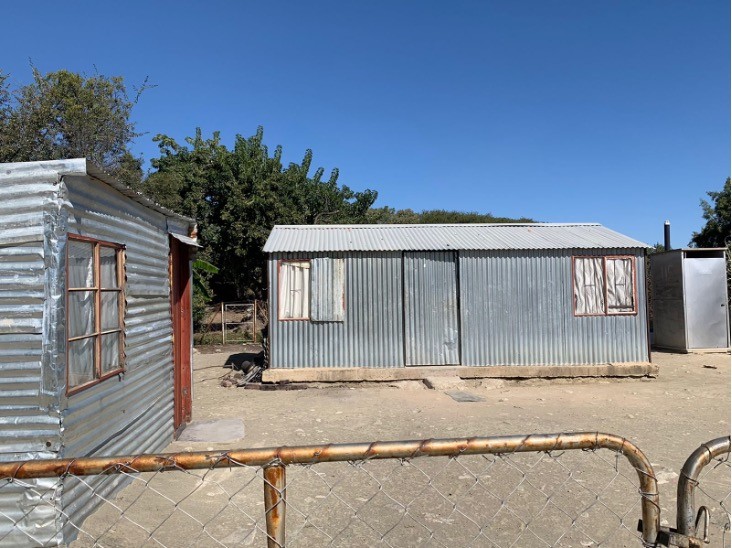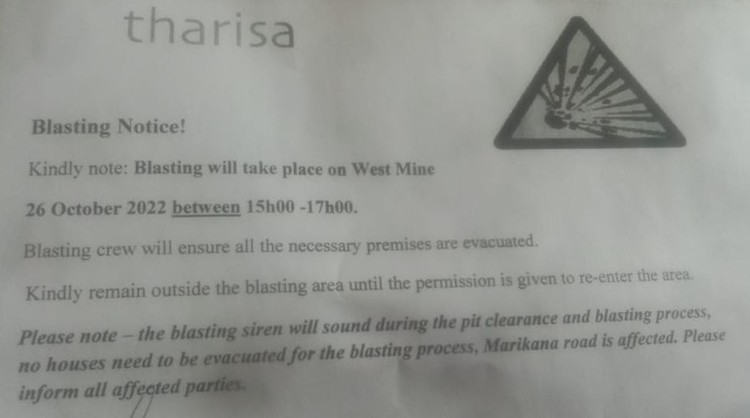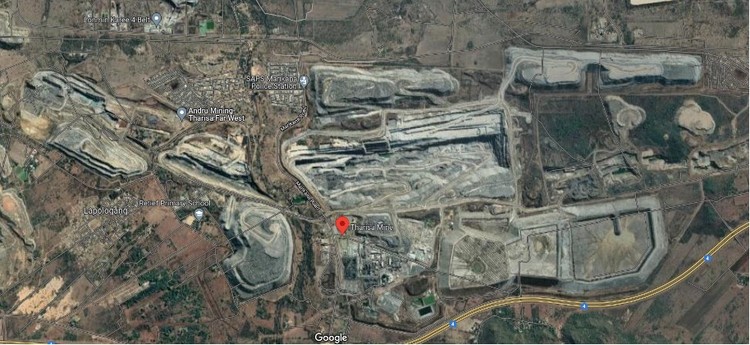Dust, flying rocks, deafening noise: blasting is a nightmare for people living near mines
Here’s what government can do about it
A house in Mmadithlokwa built by Tharisa mine for a family who were relocated due to the mine’s expansion. Photo: Danjelle Midgley
When residents of Mmadithlokwa, near Marikana in North West province, have mobile data, they record their experiences of mine blasting explosions from the nearby Tharisa mine on WhatsApp groups.
A sample of the messages posted by residents, members of the Mine Host Communities in Crisis Network (MHCCN) and other community organisations, reveals the distress caused by the noise and dust of the explosions.
Here’s an example of the kind of messages posted to such groups over a two-month period:
- 1 September: Today’s Blasting. Time 14:30. Mine Section: Far west. Vibrations: strong, houses shaking. Sound: loud
- 2 September: Blasting Time: 17:32. No vibration, Normal explosion sound. More blasting: Time 17:33. Mine: Far East section. Vibration: longer and strong. Sound: louder
- 5 September: Today’s blasting: No vibration. Sound: loud. Time 15:20. Mine: Far East Section. Too much dust
- 21 September: Blast Time: 14:58. No vibration. Loud sound. Mine section: Far East.
- 23 September: Blast Time: 14:05. Mine: Section: west section. Vibration: Strong. Sound: loud. Too much Dust
- 23 September: Time: 18:20 Mine Section: East. Vibration: strong, Sound: Very very Loud. Too much dust. The Blasting that just happened at 18:20. “THE DUST IS VERY VERY STRONG EVEN THE LIGHTS ARE DARK, WE ARE INHALING THE FUMES, WE CAN’T SEE CLEARLY, WE CAN’T SEE THE STARS, WE COUGHING BECAUSE OF FUMES NO DUST.”
- 28 September: Today’s Blasting. Mine section: far west. Vibration: strong. Sound: very loud
- 3 October: Blasting time: 14:40. Mine section: East. Vibration: None. Sound: Loud
- 6 October: Tharisa mine notice: blasting notification. Date: 7 Oct 2022. Area: West Mine, Block 3606. Blast time: 15:00 -17:00. Affected areas: Lapologang road & West pit.
- 13 October 2022: Today’s blasting. Time: 14:00. Section: West of west. Vibration: too strong. Sound: very very loud. Blasting AGAIN: Time: 15:39. Mine section: West section, close close to our houses. Vibration: too strong. Sound: extremely loud
- 14 Oct 2022: Time: 18:22 Section: East section. Vibration: too strong. Sound: very loud.
- 17 Oct 2022. Today’s blasting. Time: 13:57. Section: far west. Vibration too strong. Sound: extremely loud
- 18 October: Blasting Time: 14:10. Section: East section of mine. Vibration: very strong houses shaking. Sound: very very louder
- 24 October: Today’s Blasting. Time 14:00 Section: Far west. Vibrations: very strong. Sound: louder. IMPACTS : houses shaking
- 26 October. Mine Section: i don’t know. Vibration: very much scary and longer. Sound: very loud. IMPACTS: houses shaking up and today i ran away. TIME: 17:42
- 28 October: “There was a flying rock yesterday and it had an impact on a member who is working as … a mining subcontractor.”
- 1 November: Today’s Blasting. Time 15:37. Mine Section: far west. Tremors: strong and long. Sound: very loud
A blasting notice provided to community members by the mine on the day of the blast. Sometimes the community is informed about the mine’s blasting operations through notices. Sometimes the only warning is the loud siren immediately before the blast, warning that certain families must evacuate their homes. Sometimes there is no warning. Photo: Christinah Mdau
Mines use explosives to blast apart solid rock or ore into smaller fragments for processing. Mine blasting causes ground and air vibration shockwaves. These shockwaves have significant impacts on neighbouring communities, both physical and psychological.
These impacts are not only seen in Mmadithlokwa but also in the hundreds of other places in South Africa where mines use blasting. Texts and videos show plumes of dust and chemical fumes rising into the air above people’s houses. Voice notes describe cracked houses shaking in the blast tremors and the sour taste left by fumes in people’s throats after nearby blasts. Videos show scattered pieces of flyrock in community areas where children play and the impact of each flyrock projectile in the earth. Photos show shattered car windscreens and chicken coops strewn with freshly blasted rock pieces from the mine.
Given the serious harms of mine blasting, the Department of Mineral Resources and Energy (DMRE) and its Mine Health and Safety Inspectorate must do more to ensure proper compliance with conditions contained in blasting permits issued to mines, and work harder to meet demands by mining-affected communities for transparency and consultation.
People living close to mines using blasting want to be included in decisions, to be consulted in processes which affect them. They want to be heard and responded to when they complain about the damage to property and risks to their health and safety that mine blasting causes.
Google satellite image showing Mmadithlokwa community (top left of the picture) surrounded by Tharisa mine.
Several steps need to be taken, including
- improving the legal regime which regulates mine blasting - for instance by developing mine blasting standards which are appropriate for the South African context;
- ensuring greater involvement of communities directly impacted by mine blasting (even if they live more than 500m from the blast site) and transparency about applications made by mines for permission to blast;
- holding more meetings with communities, mines and the DMRE and its inspectorate;
- more workshops run by government on the rights that people have in relation to blasting, including how community members can hold mining companies accountable and report violations of their Constitutional right to an environment that is not harmful to their health or well-being.
- ensuring proper buffer zones around mines;
- better monitoring of blasts by government; and
- transparent communication of monitoring reports with affected parties and more site visits when complaints arise.
In addition to better public participation, monitoring and enforcement, it is time that government re-examines the formal regulation of mine blasting. At present mine blasting is not well regulated in South Africa. For instance, there are no legally binding mine blast standards which provide limits for the shockwaves generated by the explosions.
Christinah Mdau, an environmental activist based in Mmadithlokwa, has witnessed the dangers of mine blasting first-hand and regularly engages with both officials from the DMRE and the mine. She believes that to truly understand the problem, mine officials must come and see the destruction caused by mine blasting with their own eyes.
By speaking out and submitting comments on draft changes to the Mine Health and Safety Act, community members and environmental justice activists like Mdau are appealing to the DMRE to do more to improve and enforce the laws which govern mine blasting, and protect people’s constitutional right to an environment not harmful to their wellbeing.
Views expressed are not necessarily those of GroundUp
Support independent journalism
Donate using Payfast

Don't miss out on the latest news
We respect your privacy, and promise we won't spam you.
Next: Khayelitsha lesbian murder case postponed 14 times since May
Previous: Mantashe’s axing of Peter Becker was unconstitutional, rules court
© 2022 GroundUp. This article is licensed under a Creative Commons Attribution-NoDerivatives 4.0 International License.
You may republish this article, so long as you credit the authors and GroundUp, and do not change the text. Please include a link back to the original article.
We put an invisible pixel in the article so that we can count traffic to republishers. All analytics tools are solely on our servers. We do not give our logs to any third party. Logs are deleted after two weeks. We do not use any IP address identifying information except to count regional traffic. We are solely interested in counting hits, not tracking users. If you republish, please do not delete the invisible pixel.



